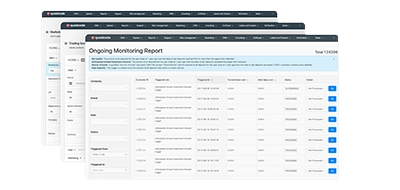Quay lại
Contents
Lệnh dừng là gì?

Iva Kalatozishvili
Business Development Manager

Demetris Makrides
Senior Business Development Manager
Lệnh dừng, còn được gọi là lệnh dừng lỗ, là lệnh giao dịch yêu cầu nhà môi giới của bạn mua hoặc bán một tài sản khi nó đạt đến một mức giá cụ thể. Lệnh này được thiết kế để hỗ trợ bạn bảo vệ lợi nhuận hoặc giảm thiểu thua lỗ trong trường hợp thị trường biến động bất lợi bằng cách tự động bắt đầu giao dịch mà không cần bạn phải liên tục theo dõi thị trường. Khi giá dừng được chạm đến trong một giao dịch, lệnh dừng sẽ trở thành lệnh thị trường. Lệnh được thực hiện ngay lập tức ở mức giá tốt nhất hiện có.
Hiểu cách hoạt động của lệnh dừng
Lệnh dừng được coi là một công cụ quan trọng để quản lý rủi ro liên quan đến hoạt động giao dịch. Khi một cá nhân đặt lệnh dừng, về cơ bản họ đang chỉ định mức giá mà họ muốn bán hoặc mua tài sản của mình và thoát khỏi thị trường nếu xu hướng thị trường trở nên bất lợi.
Khi đạt được giá dừng, lệnh dừng lỗ sẽ chuyển thành lệnh thị trường, nhưng không đảm bảo một mức giá nhất định để thực hiện. Ngoài ra, bạn có thể sử dụng lệnh giới hạn dừng để giới hạn việc thực hiện lệnh ở mức giá giới hạn hoặc một mức giá tốt hơn; tuy nhiên, nếu giá cổ phiếu nhanh chóng biến động ra khỏi mức dự kiến, lệnh sẽ không thể được hoàn thành.
Lợi ích của lệnh dừng
Việc triển khai lệnh dừng có thể mang lại lợi thế cho các nhà giao dịch và nhà đầu tư về mặt quản lý rủi ro và tự động hóa các vị thế giao dịch trong nhiều khung thời gian khác nhau, chẳng hạn như giao dịch trong ngày hoặc đầu tư dài hạn. Một lợi ích quan trọng là khả năng tự bảo vệ khỏi thua lỗ mà không cần phải liên tục theo dõi biểu đồ. Với việc thực hiện lệnh tự động, các nhà giao dịch có thể bảo vệ danh mục đầu tư và quản lý rủi ro mà không cần phải liên tục theo dõi thị trường hoặc biểu đồ.
Một lợi ích khác của lệnh dừng là chúng giúp bạn bảo vệ mình hiệu quả bằng cách khóa lợi nhuận khi giá trị tài sản của bạn tăng so với thời điểm mở giao dịch. Trong trường hợp thị trường đang có xu hướng tăng và bạn muốn giữ nguyên vị thế và tiếp tục tận dụng đà tăng, đồng thời vẫn được bảo vệ trước những biến động giảm hoặc đảo chiều tiềm ẩn của thị trường, việc sử dụng lệnh dừng là hoàn hảo. Ví dụ: bạn có thể thực hiện việc này bằng cách đặt lệnh dừng. Khi giá thị trường tăng, bạn có thể điều chỉnh giá dừng cho phù hợp để đảm bảo lợi nhuận, đồng thời bảo vệ tiền trong trường hợp biến động đột ngột.
Lệnh dừng mang lại lợi ích tâm lý bằng cách loại bỏ yếu tố cảm xúc khỏi các quyết định giao dịch mà nhiều nhà giao dịch và nhà đầu tư cảm thấy khó khăn khi tự mình xử lý - đặc biệt là khi quyết định bán tài sản giữa những lo ngại về việc bỏ lỡ cơ hội hoặc lo lắng về việc nhận ra thua lỗ sớm. Việc triển khai lệnh dừng giúp loại bỏ những yếu tố này bằng cách áp dụng một kế hoạch thoát lệnh được thiết lập sẵn, thúc đẩy cách tiếp cận có cấu trúc và logic hơn đối với các quyết định giao dịch thay vì hành động theo cảm xúc, đặc biệt là khi bắt đầu với một khoản lỗ chưa được nhận ra. Lệnh dừng lỗ là một cách dễ dàng để tăng tính kỷ luật cho chiến lược giao dịch.
Hơn nữa, lệnh dừng mang lại lợi ích cho các nhà đầu tư không thể thường xuyên theo dõi biểu đồ và giám sát khoản đầu tư của mình vì nhiều lý do, chẳng hạn như giới hạn thời gian hoặc các nghĩa vụ khác khiến họ bận rộn và không thể quản lý vị thế chủ động mọi lúc. Lệnh dừng cung cấp giải pháp bằng cách tự động hóa quy trình thực hiện, cho phép các giao dịch được thực hiện theo đúng dự kiến mà không cần giám sát liên tục. Tính năng này biến lệnh dừng thành một công cụ hữu ích, phù hợp cho cả nhà giao dịch chủ động và những người có mục tiêu đầu tư dài hạn.
Nhược điểm của lệnh dừng
Mặc dù lệnh dừng mang lại lợi ích cho các nhà giao dịch và nhà đầu tư, nhưng cũng không nên bỏ qua những nhược điểm tiềm ẩn. Điều quan trọng là mỗi cá nhân phải đánh giá cẩn thận những rủi ro liên quan đến lệnh dừng. Một mối lo ngại lớn là trượt giá có thể xảy ra khi lệnh dừng được kích hoạt. Ngay khi điều này xảy ra, lệnh sẽ chuyển thành lệnh thị trường và được thực hiện ở mức giá hiện hành. Trong thị trường thanh khoản thấp, điều này có thể dẫn đến việc lệnh được hoàn thành ở mức giá khá khác so với giá dừng, dẫn đến hiện tượng được gọi là trượt giá. Tình huống này có thể dẫn đến việc bán hoặc mua ở mức giá không thuận lợi như mong đợi khi đặt lệnh dừng và có khả năng làm giảm lợi nhuận hoặc khiến thua lỗ thậm chí còn lớn hơn.
Một nhược điểm khác là khả năng lệnh dừng được kích hoạt bởi những thay đổi giá trong thời gian ngắn và không phản ánh chính xác hướng đi của thị trường trong dài hạn. Thị trường tài chính đôi khi khá khó đoán, đặc biệt là khi nói về tiền điện tử, và giá có thể tăng hoặc giảm trong thời gian ngắn mà không báo hiệu sự thay đổi trong xu hướng thị trường. Việc đặt lệnh dừng quá gần với hành động giá có thể dẫn đến việc lệnh dừng bị kích hoạt bởi những biến động giá tạm thời này, đóng các vị thế của bạn khi bạn không có ý định làm như vậy. Điều thường khiến mọi thứ trở nên tồi tệ hơn trong trường hợp như vậy, khi bạn bán một tài sản với giá thấp hơn mong đợi, là khi bạn thấy tài sản tiếp tục biến động thuận lợi sau khi bật lại, nhưng bạn bỏ lỡ tất cả lợi nhuận và thay vào đó là chịu lỗ vì lệnh dừng.
Ngoài ra, thị trường thanh khoản thấp còn gây ra những thách thức với việc khớp lệnh một phần. Điều này xảy ra khi lệnh dừng được kích hoạt ở mức giá dừng nhưng chỉ được khớp một phần do không đủ người mua hoặc người bán để hoàn thành toàn bộ lệnh. Điều này dẫn đến việc chỉ một phần lệnh được khớp ở mức giá mong muốn, dự kiến, nhưng phần còn lại của lệnh được khớp ở mức giá kém thuận lợi hơn hoặc không được khớp. Giao dịch chưa hoàn tất này có thể khiến các chiến lược và kế hoạch giao dịch trở nên phức tạp hơn đối với nhà đầu tư vì nó có thể dẫn đến một vị thế cần xử lý.
Hơn nữa, mặc dù lệnh dừng có thể tự động hóa giao dịch và loại bỏ ảnh hưởng của cảm xúc khỏi quá trình ra quyết định, nhưng chúng cũng có thể tạo ra cảm giác an toàn giả tạo. Các nhà giao dịch có thể quá phụ thuộc vào lệnh dừng, nghĩ rằng chúng hoàn toàn an toàn, mà không tính đến những nguy cơ tiềm ẩn như trượt giá, khớp lệnh một phần, lỗi của con người khi đặt lệnh, hoặc các tình huống thị trường có thể ảnh hưởng đến việc thực hiện lệnh. Điều quan trọng là phải nhận thức rằng lệnh dừng chỉ là một công cụ, chứ không phải là một biện pháp an toàn, và chúng nên được sử dụng cùng với một kế hoạch quản lý rủi ro toàn diện.
Trong một số trường hợp, tại các thị trường bị ảnh hưởng nặng nề hoặc có khối lượng giao dịch thấp, lệnh dừng có thể không hiệu quả vì giá có thể bị thao túng để kích hoạt các lệnh đó một cách cố ý. Chiến lược này, được gọi là "săn lệnh dừng", bao gồm việc đẩy giá lên các mức mà nhiều lệnh dừng được đặt, dẫn đến một chuỗi các lệnh thực hiện có thể đẩy giá theo hướng không mong muốn. Sử dụng bản đồ nhiệt, có thể thấy các lệnh dừng đang tập trung ở đâu, sau đó đẩy giá lên các mức đó để kích hoạt các lệnh dừng đó và thanh lý các nhà giao dịch. Trong những trường hợp như vậy, nhà giao dịch có thể bị dừng lệnh chỉ để thấy thị trường phục hồi trở lại theo hướng có lợi cho họ sau khi lệnh dừng được thực hiện.
Mẹo thực tế khi sử dụng lệnh dừng
Khi sử dụng lệnh dừng hiệu quả, điều quan trọng là không đặt giá dừng quá gần hoặc quá xa giá thị trường hiện tại để tránh bị kích hoạt bởi những thay đổi thông thường của thị trường hoặc phải đối mặt với mức lỗ lớn hơn dự kiến do cân nhắc về biến động tài sản và khả năng chịu rủi ro.
Việc tích hợp lệnh dừng với các kỹ thuật giao dịch khác cũng có thể nâng cao hiệu quả của chúng! Ví dụ, việc kết hợp lệnh dừng lỗ sẽ tự động điều chỉnh giá dừng khi giá thị trường thay đổi theo hướng có lợi. Điều này có thể giúp đảm bảo lợi nhuận đồng thời bảo vệ bạn khỏi những khoản lỗ tiềm ẩn.
Việc đánh giá lại và điều chỉnh lệnh dừng lỗ theo xu hướng thị trường và phương pháp đầu tư luôn thay đổi của bạn cũng rất quan trọng. Thị trường luôn biến động; một lệnh dừng lỗ từng hợp lý có thể không còn phù hợp với điều kiện thị trường hoặc mục tiêu đầu tư của bạn khi chúng thay đổi.
Phần kết luận
Sử dụng lệnh dừng là một công cụ hữu ích cho các nhà giao dịch vì nó giúp quản lý rủi ro và bảo vệ lợi nhuận bằng cách tự động thực hiện giao dịch khi thị trường biến động bất lợi. Bằng cách nắm rõ cách thức hoạt động của lệnh dừng, tìm hiểu ưu và nhược điểm cũng như các kỹ thuật ứng dụng, các nhà giao dịch và nhà đầu tư có thể cải thiện chiến thuật giao dịch và đưa ra những lựa chọn sáng suốt trong bối cảnh giao dịch. Mặc dù lệnh dừng đi kèm với rủi ro và không phải là hoàn hảo, nhưng khi được sử dụng đúng cách, chúng mang lại cho nhà giao dịch sự an tâm và quản lý kết quả đầu tư tốt hơn.
Đã cập nhật:
19 tháng 12, 2024




